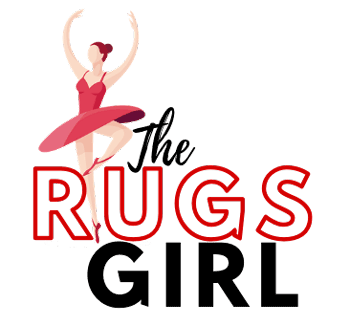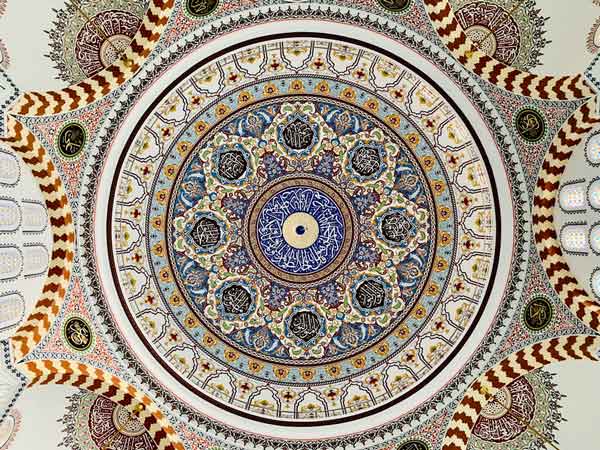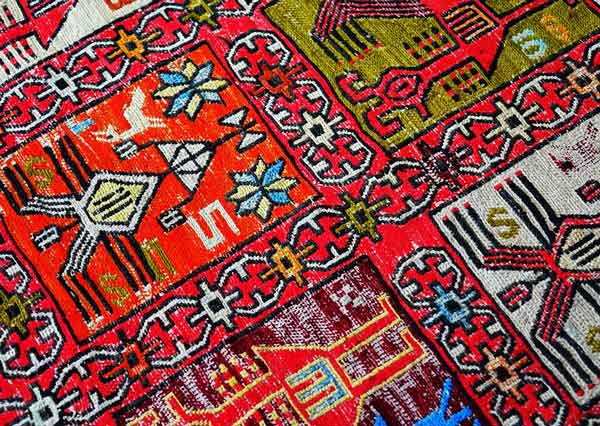What Are The Different Types Of Persian Rugs?
Persian rugs were named after cities, villages, and tribes they were made in/at. That brings us to the three major types of Persian rugs: City, tribal, and village.
In terms of superiority and quality, city rugs come up in the rank. People employed to make city Persian rugs were often called “the masters” because their skills were topnotch, and they produced high-end rugs.
Most city rugs were produced by big-name companies run and managed by well-known billionaires and business people.
On the other hand, village and tribal Persian rugs were produced at the family and local business level by people who had the skills to make handmade rugs.
Travelling, environment, customer requests, and history are some of the ways weavers of Persian rugs got inspiration on designs to create.
You can also check the guides below on how to:
- To vacuum and clean delicate antique Persian rugs
- Remove smells from Persian rugs
- Remove wrinkles, folds, and creases on Persian rugs
[table id=1 /]
WHAT ARE THE DIFFERENT TYPES OF PERSIAN RUGS IN 3 CATEGORIES?
CITY RUGS
QUM
Patterns: animal motifs, medallions, plants and gardens are some of the most common items featured in the Qum Persian rugs.
High knot count: These rugs are handmade, but looking at it, you might think it is made from a machine because they pile, and knot design brings a high-end, and more exquisite detail.
Material: Most of these types of rugs are made from woven pure silk material, which makes them more durable.
Made in: They are made in the city of Qum, also known as Ghom, Qom, and Ghome.
TABRIZ
Below are some of the features which you can use to identify a Tabriz Persian rug:
City: These rugs are made at a city known as Tehran
Central Medallion: Most Tabriz Persian rugs have a central medallion. Apart from the medallion you might find figural, pictorial and other designs on some of these rugs.
‘Tabriz Mahi’: This is the name given to the most popular design of Tabriz rugs. Mahi means fish. This design features a garden with a stream with too many fish.
Patterns: They have floral and garden like patterns. They also feature other items likes cypresses, weeping willows, and arabesques among others.
ISFAHAN
Patterns: tiles, mosques, gardens, floral and palaces are the main places of items which inspire the design of the Isfahan Persian rugs.
Made in: They are made in the city of Isfahan. This city is located in a desert and left of mount Zagros which explains why these types of rugs are rich in deep inspiration and high quality.
Design: Since these rugs are of high quality, they often have a high knot and pile count which makes them more durable and beautiful.
NAIN

Firstly, they come in neutral, solid, light, and beautiful color pellets with navy blue, pink, and ivory being the most common ones.
Secondly, most have a floral-inspired design, which makes them ideal for homes with neutral home décor designs.
Finally, Nain, the city where these rugs are made, is the home of some of the oldest mosques in history. Therefore, most of these rug conveys in-depth religious and historical information dating back in the 10th century.
Knot types: the quality of a Nain Persian rug is determined in there knot types: 4La, 6La, and 9La. “La” stands for a layer which refers to the layers of threads used to weave the rug. It is said that the lower the number, the higher the quality.
VILLAGE RUGS
KASHAN
Color: Cream and green are the most color shades these rugs come in. However, you can also find reds and creams colors commonly used.
Design: Most come in floral designs with a central medallion while others do not have the medallion.
Made in: Just like Kerman, Keshan is a city, but its rugs are classified as village rugs due to difference in quality with the city rugs.
Material: Most of Kashan Persian rugs are made from silk because this city is known for its high performing textile and pottery industries.
MOUD
Patten: Most Moud Persian rugs have the “Herati” pattern which features flowers in a rhomb and ancanthus leaves. Some rugs show fish instead of the leaves.
Design: You are likely to see a central medallion in some while others have an all-over pattern.
Made in: They are made in the village of Moud, which is found south of Mashad and Birdjan.
ABADEH

Design: The design of the Abadeh Persian rug is inspired by vase patterns, geometric designs, and Qashqai tribe culture.
Color: Most have neutral and toned-down color schemes.
How to identify them: They have hexagon figures at the center often surrounded by birds, flowers, trees, among other complementary features.
SENNEH
They were made in: Made in a small village called Senneh, located in the western part of Iran in Kurdistan province and Sanandaj capital city.
Colors: Dark blue and reds are the most popular color shades in these rugs.
Weave type: These rugs are made as piles or flatweaves, which makes them durable and elegant.
HAMADAN
Made in: Hamadan is a city with more than 134 villages in it. Therefore, you find many types of Hamadan rugs names after each village, such as Malayer, Nahavand, Hossein, and Tuyserkan, among others.
Design: You can quickly identify these types of rugs from their geometric and floral designs.
Color pellets: They come in deep colors, such as reds, navy blues, and creams, among others.
BIDJAR
Design: Their design is inspired by the “herati” which is a common fish pattern used to create these types of rugs.
Weaving style: The Bidjar rugs are often called the “king of carpets” because they are made with a unique weaving style. The brush used is made from wood and metal, which makes it though at producing highly durable and strong types of rugs.
Made in: They are made in a small village found in the west of Iran known as Kurdish.
ARDEBIL
Made in: This rug was made in Kashan near the Caspian Sea. I know you must be wondering why its named Ardebil even though it was made in kashan. This is because it was put in the Ardebil mosque after it was made, hence the name.
Design: Most come with geometric form designs.
Knot-count: They mostly have thinner piles and less knot count than other Persian rugs.
HERIZ
Distinguishing feature: They have a hexagon-shaped center design with a right-angled medallion and floral corners. Therefore, they conform to a geometric design.
Made in: They made in Heriz village found Northwest of Iran and close to Tabriz city.
Size: Most Heriz Persian rugs come in large sizes above 300 by 200 cm.
MASHAD
Made in: They are made in the city of Mashad. They are classified as village rugs, just like Kashan and Kerman, because the quality is lower than that of city rugs.
Color: Navy and red are the most common colors that these rugs come in.
Design: Mashad is known as the most “holy” city in Iran, which means you will find religious culture in these rugs. Most of them also have a central medallion.
KERMAN
Made in: Kerman is a city found in the southeast area of Iran. They are classified as village rugs although they are made in the city of Kerman because their quality is way lower than that of city rugs. However, that does not mean that they are of low quality. They have a high standard compared to other villages and tribal rugs.
Unique feature: Most Kerman Persian rugs feature over-dyed patters with a central medallion.
Material: most of these types of rugs are made from wool.
TRIBAL RUGS
BAKTIYAR
Made in: A small tribe of nomads known as Baktiyar located at the west of Isfahan city near the Zagros Mountains.
Also known as Baktiyar Persian rugs are also known or spelled as Bachtiar, Bakhtiari, and Bakhtiar.
Design: These types of rugs feature the Khesti patter, which represents a garden with animals and plants.
Material: They are made from highly thick wool material, which makes these Persian rugs the most durable.
GABBEH

Distinguishing feature: This is one of the few Persian rugs with no patter. However, you can find small trees, animals, and other features on the corners.
Purpose: The Gabbeh rugs were initially designed as sleeping rugs, which explains why they are thick, cozy, and tightly woven to feature such a strong pile finish look.
Material: Gabbeh is a local Persian word that means raw or natural. Therefore, these rugs are made from natural materials, which is thicker up to 7mm, which is 2 to 4mm times thicker than other types of rugs.
Also known as Gabba is also another name used to refer to these types of rugs.
Alternatives: Loribaft and Lori are other types of Tribal Persian rugs that are similar to the Gabbeh Persian rugs.
QASHQAI
Made in: These rugs are made by a nomadic tribe that moves around twice a year, known as Qashqai or Ghashghai. They mostly live in the southwest area of Iran but move to the Persian Gulf during winter then they go to the Zagros Mountains during summer.
Color: Reds, browns, and burgundy are the three primary base colors used in these types of rugs.
Inspiration: Since these rugs are made by nomads who love to travel from place to place, their pattern and design often feature the experiences of nomads travel, such as wildlife and nature, among others. That is why trees, birds, and animals are everyday items you expect to see in these types of rugs.
Material: They made from wool in most times because it is lighter to carry around from one place to the next. However, cotton is also used in some cases.
BALUCH
Size: Most of these rugs are made for prayer purposes, so they mostly come long and narrow like runner rugs.
Color: Reds, navy, black, and burgundy are the primary base colors used in Baluch Persian rugs.
Made in: They are made in a small tribe known as Baluch, which lives at the border of Iran and Afghanistan. That is the reason why these rugs resemble the Turkman rugs made in Afghan.
Pattern: They feature a unique nomadic weaving design, which brings out the authenticity and craftsmanship of the weavers.
Material: People living in Baluch are mainly known for agriculture and sheep raising. Thus, most of their rugs are made from sheepskin or sisal and other natural products.
AFSHAR
Color: Red and blue are the base colors mostly used.
Design: You will likely find geometric patterns with a squared medallion at the center in Afshar Persian rugs.
Made in: Made in a tribe known as Afshar, which lives in Kerman city located southeast of Iran.
Pro Tip: Persian had too many other tribes that are not mentioned in this post like the Farahan, Mir, Koliai, Yalameh, Sarouk, and Sultanabad, among others which you can find here.
FAQ’s
HOW DO I KNOW WHAT KIND OF PERSIAN RUG I HAVE?
Firstly, you can read several other guides on the types of Persian rugs like this one to clearly understand the distinctive features of every kind of that you can be able to tell when you come across one.
Secondly, you can consult a Persian rug expert who will help you to identify the significant differences and features in the rugs.
Finally, you can read this guide, which will help you to differentiate natural rugs from Persian and oriental rugs.

WHAT ARE THE BEST PERSIAN RUGS?
Read our top 5 picks section above
City Persian rugs, such as the Isfahan, Nain, and Tabriz, are the best because they have the highest quality and most beautiful design. The disadvantage is that these same unique features make them the most expensive, which is why you can also consider other amazing villages or Tribal Persian rugs, such as Heriz, Kashan, and Gabbeh, among others.
WHAT IS SO SPECIAL ABOUT PERSIAN RUGS?
Several features make Persian rugs special and unique. For example, they are handmade, which means it takes months or even years to finish some of the designs. That amount of time spent makes these rugs highly expensive and unique.
Another reason Persian rugs are so unique is the material used to make them. Most are made from silk or wool, which natural fibers are making the rug highly durable and safe for use even with babies and people with allergies.
Additionally, Persian rugs come in a wide range of designs and types, as discussed above, which means you will have a wide variety to choose from.
Finally, these rugs are ancient, meaning they tell the history of ancient Greeks dating from an early as 3000BC. The art of rug weaving was mostly started with these types of rugs, a feature that makes them unique.

WHAT IS THE DIFFERENCE BETWEEN PERSIAN AND ORIENTAL RUGS?
The words Persian rugs and oriental rugs are often used interchangeably. Both types of rugs are ancient, are made from natural fiber, are highly durable, and are too valuable, usually expensive and mostly handmade.
However, they have several differences, such as the country of origin. Persian rugs are only made in Persian, known as Iran today. At the same time, oriental rugs are made in Persia but also in other countries such as China, India, Turkey, Egypt, and Tibet, among others.
Another difference is in the knot type. All Persian rugs are hand-knotted while the same cannot be said about oriental rugs because some are machine-made, especially those made outside Turkey and Iran.
Finally, another difference can be found in the method of washing. Most Persian rugs can be washed with hands because they are soft, while machine-made oriental rugs will be difficult to clean with hands.

WHAT ARE THE DIFFERENT TYPES OF ORIENTAL RUGS?
There are many types of oriental rugs, such as Chobi Ziegler, Persian rugs, Ikat rugs, Bokhara rugs, Flatweave Kilim rugs, Vogue and modern rugs, overdyed rugs, silk rugs, and patchwork rugs among others.
HOW EXPENSIVE IS A PERSIAN RUG?
The material used, time taken to create, size, and the number of knots are the main features used to determine the price of a Persian or Oriental rug. Knots are the number of weaves used per square inch. Persian rugs have 60 to 1000 knots per inch. The higher the knots means, the softer the final rug will be, which will make it higher in quality and price.
Similarly, creating more knots will consume more time and takes more materials, which makes Persian rugs with high knot count more expensive.
For example, a six by nine hand-knotted Persian or oriental rug will cost around $1000 to $5000 depending on the number of knots count used.





















